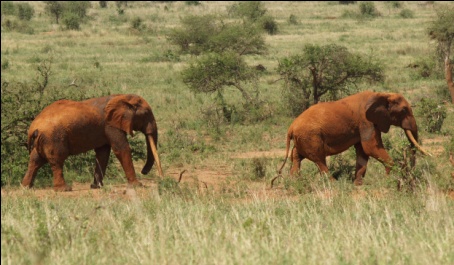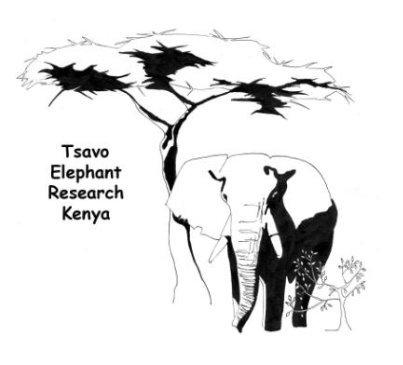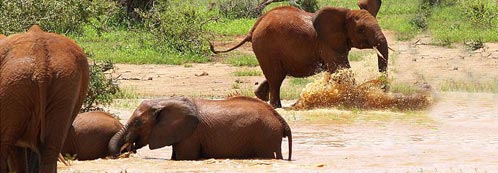Field Notes
January - March 2012
It was hot and humid with a few storms in some areas during January. Due to the plentiful rainfall in November and December of last year the main waterholes remained full. In early-February there was one adult hippo in the Irima waterhole and a few weeks later another adult arrived. A few years ago a female hippo with her very small calf were at this waterhole but they didn’t stay long. Hippo’s often move from Galana River south to waterholes during the rains.
Although I’ve seen a lion climb a tree in Tsavo before, it is a rare behavior. In February, I watched a lioness climb a tree and her three small cubs tried to follow but only got a short distance off the ground before tumbling back down. After these failed attempts to follow using the same branch as their mother, the cubs stayed on a lower branch and waited for the female to climb down. The lioness appeared to be surveying the area as the grass was very tall.
Bulls
Many small and large groups of bulls were in the bull area during January and February. I was watching a group of bulls one early morning when an Aardwolf ran across the road, darted behind the bull group and ran into the bush. The group of bulls watched the Aardwolf for a few minutes than went back to feeding. With a hippo residing in the waterhole favored by bulls, some of them appeared reluctant to swim near the hippo while other bulls slowly walked in and the hippo moved to the far side of the pool. Dusk as usual stood at the edge of the waterhole until another bull went in then he followed.
In March, Dusk, Arrow and Dart were together near Irima waterhole. Dusk and Arrow were close together under one tree and Dart under another tree. A monitor lizard approached Arrow and Dusk. Arrow raised his head and kicked soil at the lizard as it began to climb “their” tree. Dusk became alarmed and moved quickly away with Arrow following him. They joined Dart at his tree. When the lizard climbed down and moved off into the bush Arrow and Dusk moved back to “their” tree.
Irima waterhole was a bit crowded in February, with large groups of buffalo, zebra, hartebeest two hippos and even Ostrich. Thorn, Sampson and four young males approached the waterhole where a group of buffalo were resting under the nearby shrubs. Thorn went directly to the waterhole to drink and splash, Sampson walked up to the buffalo and they moved away. When Sampson moved to the waterhole to drink the buffalo moved back to the shrubs. When Thorn turned toward the shrubs with the buffalo he extended his trunk toward them but the buffalo did not move away. When he shook his head they still did not move so he moved off to a tree to scratch and rest.

Darwin and Rudolf returned to the bull are in February. They were in a bull group of 16 with Aries, Nathan, Arthur and Orbit. Five of the bulls were very large (older than 45 years). Darwin and Troy are long-term companions and they stayed together for 3 weeks. Troy was last seen a few years ago outside the park on private land adjacent to the park. He is one of 13 bulls that move back and forth between the National Park and private land (Photo Darwin left, Troy right).
In February Livingstone was alone in the bull area, but at first I did not recognize him because he had lost his right tusk. When I saw him in November of last year, south of Voi River, he had 2 tusks. But now the tusk socket was empty. He appeared healthy and was feeding normally. In February and March he was often in medium size bull groups of five to nine bulls.
Families
With abundant resource many families aggregated with bulls in the northwestern region of the park. Eldora’s family was with Sandstone and another large bull, first feeding in a glade and then they move as a group to a waterhole to drink and mud-wallow. A week later Eldora’s family and Tessa’s family were together at the west base of Irima Hill. Then two weeks later the two families were still together heading toward the river.
In January, Holda’s family and Hazel’s family were together near the south base of Irima Hill. Ten days later they had moved south and a young male had joined them. Then in March Holda’s family was alone feeding at the base of a hill.
In February Athena’s family was with three other families and Sun, a bull 35-40 years old, in musth, at a waterhole. Sun was guarding a young female. Often when there is a musth bull with a family, non-musth bulls are attracted to the activity. In this aggregation there were five bulls, 20-25 years old, watching Sun. When the female moved, Sun followed as did the other bulls. If the bulls got too close, Sun folded his ears and stood very tall and the bulls backed off but did not move away.
April - October 2012
It rained in April filling many waterholes and in some areas the vegetation was green One of the two hippos left Irima waterhole in early April and the second one left two weeks later. The Eurasian Rollers left the north western region in April. It was very cool and windy in June and July drying the vegetation and most of the waterholes had small drinking pools or were dry. Rains were patchy in the western region in early October, not enough to fill the waterholes, but many of the plants turned green again. But, in the eastern region, many of the waterholes filled and the vegetation was green.
Bulls
Bulls associated in groups of four to 12 bulls from April through June. Some of the bulls moved to Voi River where they aggregated into groups of 20-24 bull. From July to September the bull groups were smaller, two to six bulls in a group.
Then in October some of the bulls were alone and although there were a few groups of five to six bulls many of the bulls left the bull area.
On two separate occasions Sunray and Pisces were digging-up tubers. They bent down and used their tusks to dig-up the tubers at the base of a bush. During another sighting a group of 8 young bulls (12-16 years) were resting under a tree when a bull 25 years old moved toward an adjacent tree. He extended his trunk up to one of the branches but couldn’t reach it, so he balanced on his hind legs and stretched his trunk up and this time was able to pull down a branch. One of the young bulls left his group and slowly approached the older bull. The older bull flapped his ears twice and the young bull responded with two ear flaps. Within a few minutes they were sharing the branch that the smaller bull could not have reached.
In April Rudolf was with five bulls drinking from a waterhole. A few days later he was with a young newly independent bull at the same waterhole. Darwin was with four to six bulls on numerous occasions including Aries, Sunray, Sun, Quasar and Knox – all younger than he is. On one occasion he was with Tiberia’s family feeding on Acacias. Livingstone was in bull groups of three to eight bulls with many of his long-term associates: Dusk, Sandstone, Ripley, Quasar and Sunray. Sandstone was in bull groups of three to 11 bulls. In some groups he was the oldest bull in the group with young males following him. He was with many of his long-time associates: Arrow, Dusk, Sunray, Livingstone, Ripley, Skylight and Sampson. He and Dusk enjoy swimming in Irima waterhole together; submerged and then stood up shaking their heads while swirling their trunk over the surface of the water.
Families
Many families spent April through late August in the northwestern region. In May, families aggregated into groups of more than 50 per group. On one occasion I was driving through a narrow pass between two hills and met a group of 100 elephants also moving through the pass. But when I started to turned around to get out of their way, there was another aggregation behind me. I was surrounded, I couldn’t go forward or back, so I turned off the engine and waited. A family of 18 crossed the road in front of me. Then a young male, who was with another young male from a different family, suddenly realized his family was gone. He trumpeted and charged, but I couldn't get out of his way with elephants all around. He then dashed across the road, met his family who trumpeted and surrounded him.
Between April and July Holda’s family and Hazel’s family were often together, feeding in an open grassland habitat in the western region. In September, Chrystal’s family was resting under an Acacia with another family near Voi River. Eldora’s family and Tessa’s family were together for several days than a week later the two families separated. In early October Eldora’s family was resting and feeding under an Acacia. Skye was eating on a long-wide strip of Acacia bark when Eldora moved from the other side of the tree, extend her trunk toward Skye and pulled on the bark. Skye let go, backed-up and then moved back to the tree using her tusks to strip another section of bark. A young male (8-10 years old) moved toward Eldora and picked-up the end of the strip that was on the ground. Eldora flapped her ears and pushed the male away with her trunk. He backed away and walked toward Skye, who was eating part of a new long strip of bark. Again he picked-up the end of the strip from the ground, but this time, he was able to share the bark with Skye.
November - December 2012
The rains started in early-November and continued through December. Some areas were flooded and waterholes were overflowing. Barn Swallows arrived just after the rains started and a few small flocks of Eurasian Rollers arrived in December. A hippo arrived at the Irima waterhole in mid-December. With the heavy rains, resources were abundant and widespread so elephants dispersed to their wet season range. On numerous occasions there were aggregations of 100 elephants. This is also the time when elephants are the most vocal: trumpeting and rumbling.
Bulls
Even with heavy rains in November and December they were patchy in the bull area and some waterholes were dry in December. But, the vegetation was green and thick with many shrubs flowering. Bulls were sighted on numerous occasions feeding on the blossoms of Bauhinia taitensis.
Some of the known bulls left the bull area in November, although Dart, Skylight, Arrow, Sunray and Ripley stayed in the area until mid-December. Most of the bull groups were small groups of two to four bulls and most of the groups were comprised of young (10-15 years old) newly independent males. Skylight was alone on two occasions and one of these sightings he was in musth - and charged. He followed my Suzuki, along the road for over 300 meters, then turned and moved into the thick bush. Livingstone was with Saturn in December, south of Voi River, which is part of Livingstone wet season range.
Families
Many families increased their range with the rains, from the northwestern region during the dry season, south to Voi River and aggregated with other families to socialize. On one occasion several families aggregated in an open grassland area. I was checking tusks and ear notches to identify the adult females when suddenly four young males (8-10 years old) rushed out of the bush toward the families, trumpeting and then stopped at the edge of the bush looking back. Since the adult females did not seem alarmed by this behavior I wasn’t sure what these young males were responding to, but I soon found out. A few minutes later a large bull 45 years old, in musth, came out of the bush where the young males had come from. When he emerged from the bush toward the families the young males ran up to him and trumpeted. Compared to this musth bull these young males were very small. The adult females turned toward the musth bull and slowly moved toward him, then they all moved off into the riverine and out of sight. In all the excitement I wasn’t able to identify the adult females and the bull did not have any distinct features.

Tsavo Elephant Research Needs Your Help.
Donations are needed to continue this 30+ year field study
and support a Kenyan research field team.
We monitor the behaviors of Tsavo known bulls and families:
group dynamics, offspring & survival, musth cycles and habitat use.
Please click here or on the donate button
to send your donation.
Thank you!
Barbara
